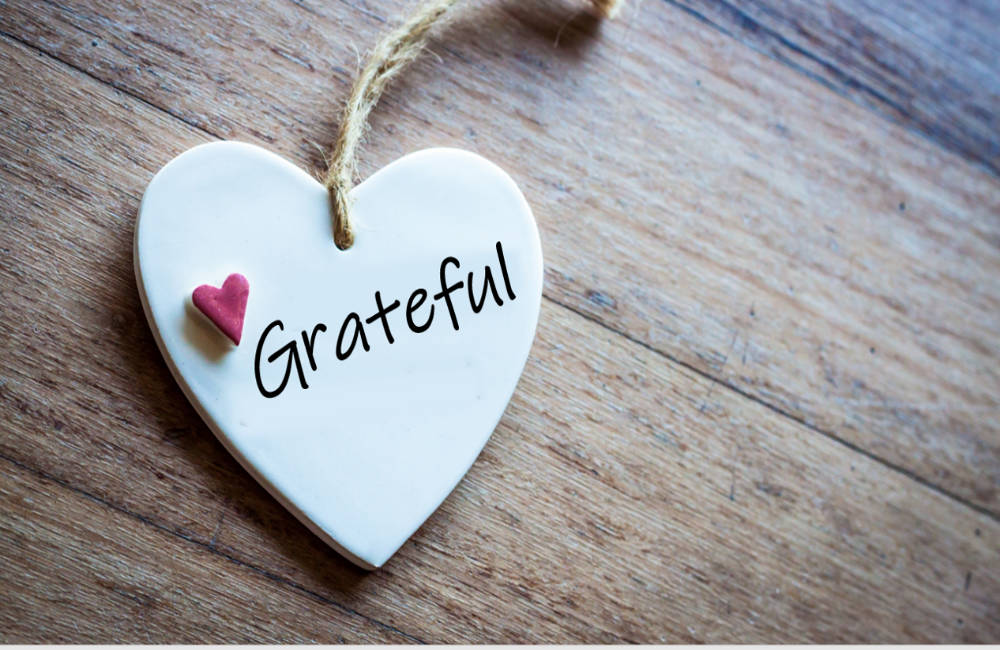HARNESSING THE POWER OF GRATITUDE FOR A HAPPIER LIFE
Do you want to feel miserable?
I sure don’t.
But it’s really easy to get sucked into complaining about everything, even when things are going well.
So, what’s the antidote?
Living in gratitude.
Living in gratitude makes your life happier and more satisfying.
When you express gratitude toward yourself, others and things in your environment you generate pleasant moments. You form memories of positive events in your life.
Being grateful magnifies the good. It de-emphasizes the negative.
Expressing your thanks reduces stress and increases recognition of the contributions you and others have made to your life. This strengthens your social connections and self-worth.
Studies show that grateful people are more agreeable, more open, and less neurotic.
Furthermore, gratitude is related negatively to depression and positively to life satisfaction.
And the more grateful you are, the more present you are in life.
With all of these benefits, how can you cultivate gratitude to increase your well-being?
PRACTICE GRATITUDE AND CREATE A HABIT
Being overly absorbed by negative events was a necessary survival mechanism passed down from our ancestors.
You’re hard wired toward negative thinking.
But far from helping you survive, constant streaming of negative thoughts can quickly derail your health. It sets you up for anxiety and depression.
You can think about a negative event to help avoid repeating it in the future. However, spending too much time thinking about what’s bad in life isn’t helpful.
To overcome your brains natural catastrophic leaning, you need to practice the skill of thinking about what’s going well.
Gratitude, as in showing appreciation and kindness, is a skill you can develop with practice.
You can practice cultivating gratitude in your life as a formal activity and informally on the spot throughout your day.
Here are 13 popular gratitude practices and activities to help you harness the power of gratitude.
As you practice gratitude, you come in contact with its “good feeling” and positive rewards.
These feelings and rewards strengthen gratitude as a long-term behavior that benefits your well-being daily.
Begin appreciating, enjoying and celebrating what’s going well, those positive experiences across your day.
Capture the good and express what’s good about it.
When the negative thoughts start pouring in, let them go.
Letting go and practicing a positive perspective opens the door for gratitude. It diminishes the power of negativity in your life.
How many ways can you practice gratitude across the day?
What opportunities are you missing to capture positivity in your day?
“Cultivate the habit of being grateful for every good thing that comes to you, and to give thanks continuously. And because all things have contributed to your advancement, you should include all things in your gratitude.” ― Ralph Waldo Emerson
EXPRESS GRATITUDE WITH PRESENCE
Often, “thank you” is said casually or quickly and in a way that’s nearly meaningless.
Express your gratitude in a thoughtful, purposeful, present way.
For example, show present attention toward the person receiving the thanks.
Use meaningful and specific words that reflect the quality or strength the person demonstrated.
Example, “Your honesty and commitment to this project are appreciated” verses “Thanks for telling me that.” Or “The enthusiasm and support you show me really helps my confidence” verses “You’re so nice.”
Can you “feel” the difference in the effect that has on your behavior as the giver and as the receiver?
The benefits of gratitude are affected by your presence and the words you use when you’re the giver. Also, the benefits of gratitude are affected by your presence and acceptance of the words of another as the receiver.
How real is your gratitude?
Do you accept offers of gratitude or push them away?
Are you reaping the benefits of gratitude across the day?
You’ve been given a gift of 86,400 seconds in a day. Have you used one of them to say thank you? -William Arthur Ward
CAPTURE GRATITUDE
Capture the Good Exercise
Martin Seligman , the founder of Positive Psychology, has done extensive research on this topic.
He demonstrates that writing down three good things that happen and why at the end of the day will noticeably improve feelings of happiness and other positive emotions.
He calls this the “What-Went-Well Exercise,” also known as “Three Blessings”. Watch his two minute video here on the benefits of positive thoughts and this exercise.
Three Blessing Steps
Each night before you go to sleep:
1. Think of three good things that happened each day.
2. Write them down daily.
3. Reflect on why they happened.
This exercise is to be done each night before going to sleep.
STEP 1: Think about anything good that happened to you that day. It can be anything at all that seems positive to you. It doesn’t have to be anything big or important. For example, you might recall the fact that you enjoyed eggs for breakfast. On the other hand, you might also recall that you meant the love of your life on that day. Anything from the most mundane to the most exalted events. As long as it is a good, positive, happy thing to you.
STEP 2: Write down these three positive things.
STEP 3: Reflect on why each good thing happened. Determining the “why” of the event is the most important part of the exercise. For example, you might say that your eggs tasted great because they came from chickens raised by your best friend. Or, you might say that you meant the love of your life on that day because you accidentally spilled food on him as his waitress. You get to decide the reason for the importance of the event for you.
Seligman states that you’ll be less depressed, happier, and addicted to this exercise after six months of doing it.
So, stick to writing about your positive events, even if it feels awkward at first. Give this process time to become an easy, enjoyable behavior.
The effort of being grateful is minimal considering the overall benefits that you reap.
“Feeling gratitude and not expressing it is like wrapping a present and not giving it.” – William Arthur Ward
SEEK GRATITUDE
If you desire to be more grateful, seek out those who are.
Some people bubble over with enthusiasm and gratitude for life. They’re magnetic. They draw you in with their love of life in every circumstance.
“In life, one has a choice to take one of two paths: to wait for some special day–or to celebrate each special day.” – Rasheed Ogunlaru
Here’s 40 more ways to practice gratitude.
Over to you…
In what ways do you express your gratitude daily, formally or informally?
Who can you express gratitude toward today?
What’s holding you back from expressing gratitude?
What benefits could you experience in trying the Three Blessings exercise?
Wishing you Wellward!
Linda

Sign up today to receive the “Tools to Meet Your N.E.E.D.S.” ebook, which contains Linda’s favorite products and practices for wellbeing.
You’ll also get notified about new resources and learning opportunities from Wellward.
Discover over 200 resources to help you reach optimal health and wellness. Explore links, apps, books, articles, podcasts, videos and more!





